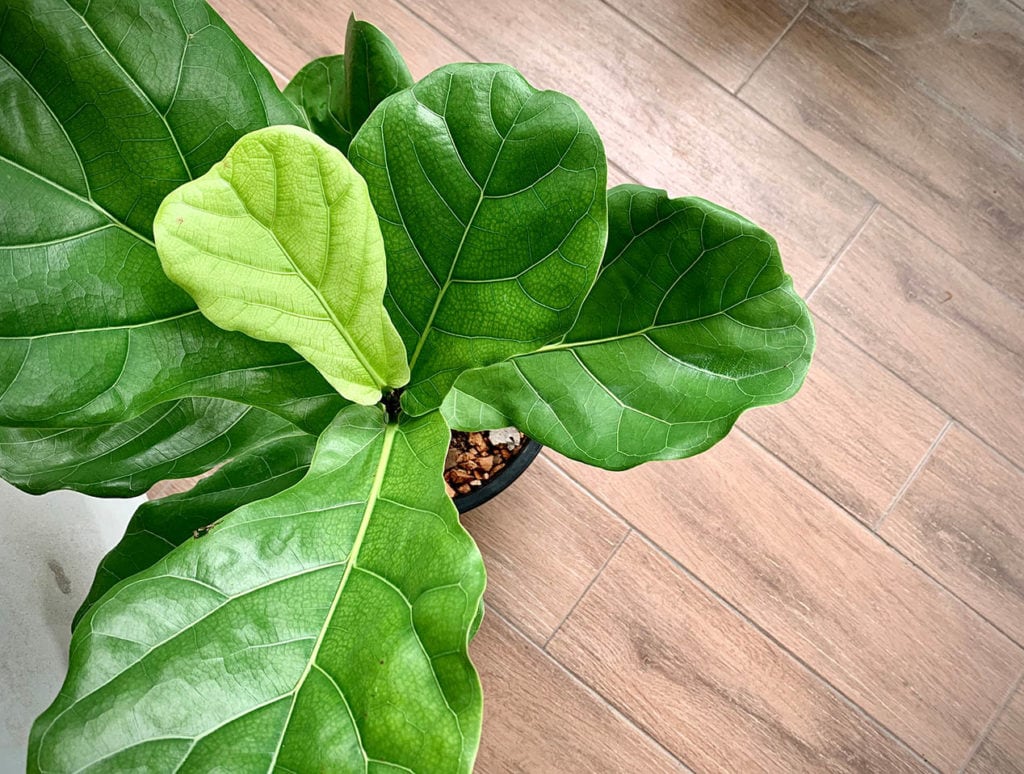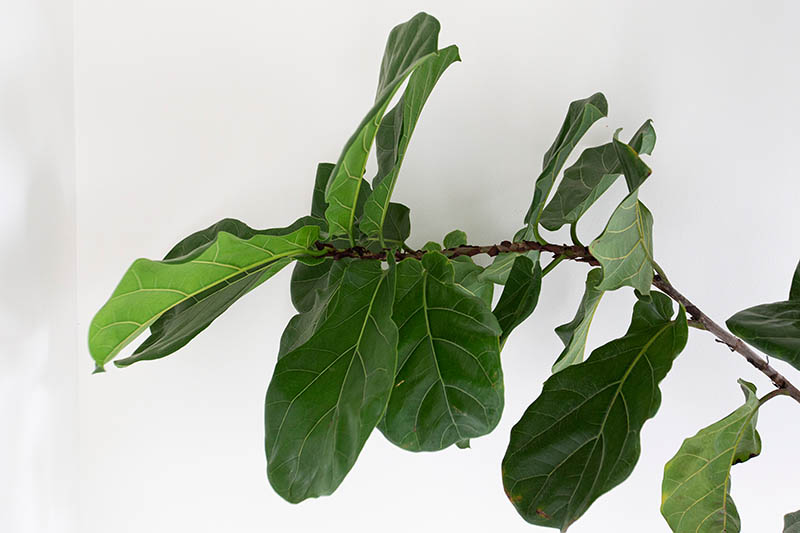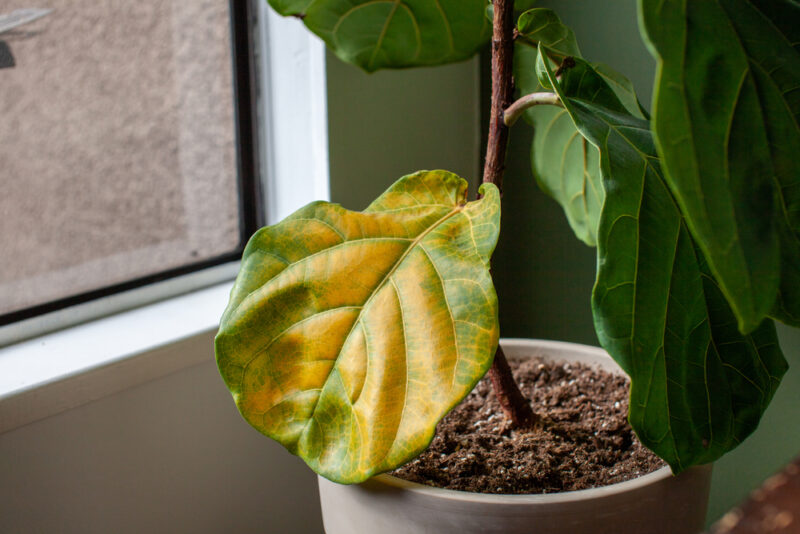Is My Fiddle Leaf Fig Dead? (6 Signs To Look For)
-
Pete Ortiz
- Last updated:

You lose more than a houseplant when your beloved fiddle-leaf fig dies. A prominent, well-tended plant enhances the home’s atmosphere, directing the mood and centering the feng shui in truly tranquil spaces. Strip it away, and you throw the entire aura off balance!
That might be a little dramatic, but so is the decision to pitch your fiddle leaf fig if it’s starting to look drab, lifeless, and leafless. Plants are remarkably resilient, and with proper care, your fiddle leaf plant doesn’t have to be an exception. Learn the critical signs of a dying fiddle-leaf fig and what you can do to get it back on track.
The 6 Signs Your Fiddle Leaf Fig Is Dying
1. Losing Leaves

Cause: Overwatering, underwatering
Fiddle-leaf fig plants will drop their leaves if they suffer from improper watering or temperature changes. New arrivals may shed a few leaves as they acclimate to the home. You may also unknowingly have your fiddle-leaf fig sitting near a vent or heat source. But when it loses over half of its leaves, it’s a fair sign that it’s dying.
You’ll likely see the leaf drop due to overwatering, which is the overarching issue surrounding most fiddle-leaf fig setbacks. Fixing the drainage problems will be essential if the soil is holding too much water, or you may have to cut back on your watering schedule.
Underwatering
Leaves can also drop if you’re underwatering your fiddle leaf fig. You can sometimes distinguish between underwatering and overwatering by the leaf color. Brown spots and edges are a sign of overwatering, while pale yellow indicates a lack of water.
2. Brown Spots on Leaves
Cause: Overwatering
Fiddle-leaf figs often fall victim to root rot due to overwatering or poor soil drainage. As the fungal infection damages the roots, it travels up to the leaves, where nutrients deposit, causing visible damage. Alongside the leaf loss, you’ll often see dark brown, burnt-looking spots near the center vein, across the leaf surface, or around the edge.
3. Curling and Browned Leaf Edges
Cause: Underwatering
A thirsty fiddle-leaf fig is easy to spot. The lack of water will be apparent in the browning at the edge of the leaves. The foliage will droop and curl, and you may notice the soil in the pot contracting.
Fixing an underwatered fiddle-leaf fig is simple enough when you catch the early signs. Keep the plant away from heat sources and anything that may dry it out. Water it thoroughly to get it back on track.
If you haven’t altered your care routine, the indoor environment may have shifted, with slightly higher or lower temperatures changing the plant’s needs. Setting up a humidifier or misting it gently every 2–3 days can be essential in keeping it nourished and thriving.
4. Yellowing Leaves

Cause: Overwatering, insufficient light, bacterial infection
Yellowing leaves can indicate one of several issues, including overwatering, poor sunlight, under-fertilizing, and bacterial infections. Fiddle-leaf figs may also show signs of stress after transplanting.
Poor nutrition can change the color of fiddle-leaf fig leaves from lush green to yellow. Root rot infection may stifle uptake, while improper fertilization might deprive the plants of available nutrients. Consider your watering habits and check for other signs of overwatering. Ensure the plant is well-fertilized and positioned to get 6–8 hours of indirect sunlight.
A bacterial infection may also make itself known through yellowing leaves. In this instance, the young leaves are the most susceptible. If you notice new growth turning yellow with spreading brown spots, it could signal an infection that can eventually doom your fiddle-leaf fig. Remove any affected leaves, and repot the plant in new soil to prevent it from dying.
5. Wet or Mushy Roots
Cause: Overwatering
If the leaves drop and develop dark brown spots, pull the plant from the pot to look at the roots. Rotting roots will be waterlogged, dark, and mushy, and you may notice an off-putting smell.
6. Brittle Branches
Fiddle-leaf fig branches, leaves, and stalks should be supple and flexible. As your plant goes longer without water, it will begin to droop, eventually developing dry, crispy edges on the leaves.
Severely dried-out and unsalvageable leaves will need immediate removal to help the plant redirect its energy toward new growth. Carefully inspect the plant as you remove dying leaves and branches to avoid removing potential healthy growth. Trim anything showing signs of infection, mold, or insect damage.
Whether overwatered, underwatered, or infected, your fiddle-leaf fig might be dead when the stalk is dry and stiff with no healthy branches. Feel the plant for any supple or green spots. If you can’t find any bright spots where the plant has a chance for new growth, you’re likely better off getting another plant.
Fixing Root Rot
Acting fast is critical in saving a fiddle-leaf fig with root rot. Infections can travel to other houseplants, and you’ll have to remove the diseased section to stop it from consuming your plant.
A fiddle-leaf fig suffering from root rot needs a break from watering and, in some cases, a fresh start. If root rot is only starting to set in, you may be able to let it dry out for a couple of weeks to allow the roots to recuperate. But if there are numerous brown spots, you may need to repot the plant.
Repotting a Damaged Fiddle Leaf Fig
Remove the plant from its pot, and tend to the roots. Rinse them thoroughly before trimming off damaged and soggy roots with a clean pair of shears. Cut off any brown-spotted leaves as well.
Put the fiddle-leaf fig in a pot with good drainage and fresh, fast-draining soil. Water the plant once to establish it in its new home. Then give the roots plenty of time to dry out. Your plant may suffer some shock after transplanting, so don’t worry too much if it starts to shed a few leaves.
Letting your plant dry out thoroughly before the next watering is crucial. A moisture meter can come in handy to keep the soil in check, but you can also do a simple test by sticking your finger about 2 inches into it. You can give your plant more time to dry out if the soil is still moist.

Saving a Fiddle Leaf Fig
Gentle care can revive a fiddle-leaf fig plant on the verge of death, and you’ll be surprised by how resilient it can be with even the slightest glimmer of hope. You can bring your plant back from the edge with thoughtful, consistent care. Here are a few essential rules to follow:
- Water once weekly, ensuring the soil dries between waterings
- Provide 6–8 hours of bright, indirect sunlight to prevent sunburn
- Prune dead leaves and branches frequently to encourage new growth (remove no more than 30% of the leaves at any time)
- Avoid transplanting as much as possible, as fiddle leaf figs stress easily
- Apply a 3-1-2 fertilizer monthly during the growing season
- Maintain 30–65% humidity, employing a humidifier as needed
- Aerate the soil to improve drainage if necessary
A fiddle-leaf fig doesn’t respond to change gracefully, whether good or bad. Setting it up in a better location with improved soil and fertilization can jar the plant, sending it into mild shock and making it seem like it isn’t doing well.
Patience is key; the plant may take a few weeks to recover. By keeping a steady and gentle care routine, you’ll see it make a turnaround within a few weeks.
Conclusion
When our houseplants speak up, we have to listen. A struggling or dying fiddle-leaf fig plant will attract attention in the worst ways, letting you know when it needs extra care through shedding leaves, dull coloration, and a wilted stature. But with the proper approach and understanding of what to look for in a dying fiddle-leaf fig, your plant will gladly reward you with its lush foliage and vibrant presence in the home.
Featured Image Credit: SURKED, Shutterstock
Contents



